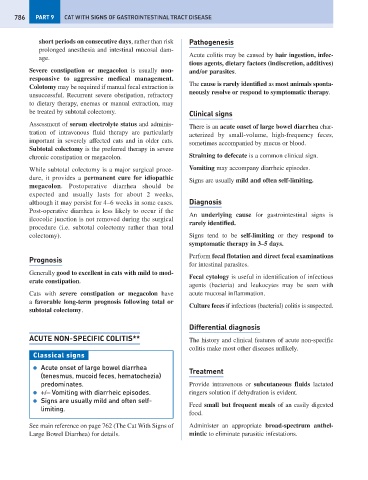Page 794 - Problem-Based Feline Medicine
P. 794
786 PART 9 CAT WITH SIGNS OF GASTROINTESTINAL TRACT DISEASE
short periods on consecutive days, rather than risk Pathogenesis
prolonged anesthesia and intestinal mucosal dam-
Acute colitis may be caused by hair ingestion, infec-
age.
tious agents, dietary factors (indiscretion, additives)
Severe constipation or megacolon is usually non- and/or parasites.
responsive to aggressive medical management.
The cause is rarely identified as most animals sponta-
Colotomy may be required if manual fecal extraction is
neously resolve or respond to symptomatic therapy.
unsuccessful. Recurrent severe obstipation, refractory
to dietary therapy, enemas or manual extraction, may
be treated by subtotal colectomy. Clinical signs
Assessment of serum electrolyte status and adminis-
There is an acute onset of large bowel diarrhea char-
tration of intravenous fluid therapy are particularly
acterized by small-volume, high-frequency feces,
important in severely affected cats and in older cats.
sometimes accompanied by mucus or blood.
Subtotal colectomy is the preferred therapy in severe
chronic constipation or megacolon. Straining to defecate is a common clinical sign.
While subtotal colectomy is a major surgical proce- Vomiting may accompany diarrheic episodes.
dure, it provides a permanent cure for idiopathic
Signs are usually mild and often self-limiting.
megacolon. Postoperative diarrhea should be
expected and usually lasts for about 2 weeks,
although it may persist for 4–6 weeks in some cases. Diagnosis
Post-operative diarrhea is less likely to occur if the
An underlying cause for gastrointestinal signs is
ileocolic junction is not removed during the surgical
rarely identified.
procedure (i.e. subtotal colectomy rather than total
colectomy). Signs tend to be self-limiting or they respond to
symptomatic therapy in 3–5 days.
Perform fecal flotation and direct fecal examinations
Prognosis
for intestinal parasites.
Generally good to excellent in cats with mild to mod-
Fecal cytology is useful in identification of infectious
erate constipation.
agents (bacteria) and leukocytes may be seen with
Cats with severe constipation or megacolon have acute mucosal inflammation.
a favorable long-term prognosis following total or
Culture feces if infectious (bacterial) colitis is suspected.
subtotal colectomy.
Differential diagnosis
ACUTE NON-SPECIFIC COLITIS** The history and clinical features of acute non-specific
colitis make most other diseases unlikely.
Classical signs
● Acute onset of large bowel diarrhea Treatment
(tenesmus, mucoid feces, hematochezia)
predominates. Provide intravenous or subcutaneous fluids lactated
● +/- Vomiting with diarrheic episodes. ringers solution if dehydration is evident.
● Signs are usually mild and often self-
Feed small but frequent meals of an easily digested
limiting.
food.
See main reference on page 762 (The Cat With Signs of Administer an appropriate broad-spectrum anthel-
Large Bowel Diarrhea) for details. mintic to eliminate parasitic infestations.

